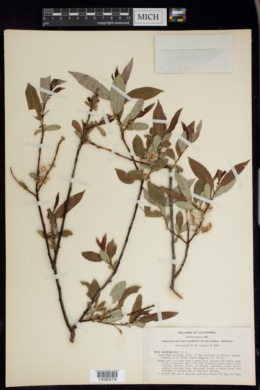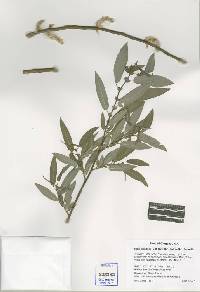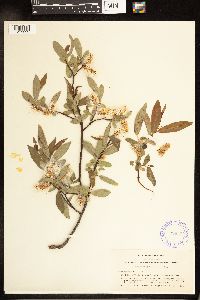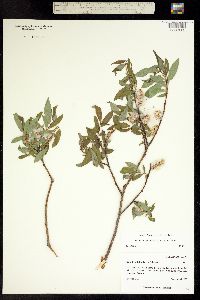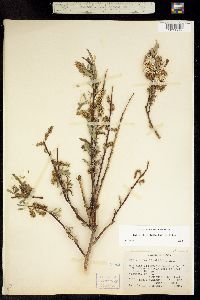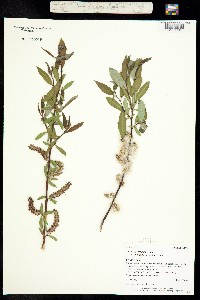Salix ligulifolia
|
|
|
|
Family: Salicaceae
Strap-Leaf Willow, more...strapleaf willow
[Salix cordata var. ligulifolia (Ball) L. Kelso, moreSalix eriocephala var. ligulifolia (Ball) Dorn, Salix lutea var. ligulifolia Ball, Salix rigida subsp. ligulifolia (Ball) E. Murr.] |
Shrubs, 1-8 m. Stems: branches yellow-brown, gray-brown, or red-brown, not glaucous, glabrous or villous; branchlets yellow-green or yellow-brown, glabrous, sparsely to densely villous, or velvety, (inner membranaceous bud-scale layer free, not separating from outer layer). Leaves: stipules foliaceous, apex rounded, convex, acute or acuminate; petiole convex to flat, or shallowly grooved adaxially, 3-18 mm, glabrous, pilose, or velvety to glabrescent adaxially; largest medial blade lorate, narrowly oblong, or narrowly elliptic, 60-133 × 12-30 mm, 2.9-6.4 times as long as wide, base rounded, convex, or subcordate, margins flat, usually serrulate or serrate, rarely (apparently) entire, apex acuminate to acute, abaxial surface glaucous, glabrous, sparsely short-silky or pubescent, hairs straight or wavy, adaxial dull, glabrous, sparsely short-silky, or midrib pubescent; proximal blade margins entire, serrulate, or crenulate; juvenile blade reddish or yellowish green, glabrous or sparsely to moderately densely pilose or puberulent abaxially, hairs white. Catkins flowering as or just before leaves emerge; staminate stout, 20.5-34 × 8-11 mm, flowering branchlet 0-3 mm; pistillate moderately densely flowered, slender to subglobose, 15.5-49 × 8-18 mm, flowering branchlet 1-6 mm; floral bract brown or bicolor, 0.8-1.6 mm, apex acute or rounded, abaxially hairy throughout or proximally (hairs usually arising from rachis), hairs wavy or curly. Staminate flowers: adaxial nectary narrowly oblong, oblong, flask-shaped, or triangular, 0.3-0.8 mm; filaments distinct or connate less than 1/2 their lengths (or appearing as a single stamen), glabrous or hairy basally; anthers purple or red turning yellow, (ellipsoid or globose), 0.5-0.8 mm. Pistillate flowers: adaxial nectary oblong, narrowly oblong, or flask-shaped, 0.3-0.9 mm, shorter than stipe; stipe 0.9-2.5 mm; ovary pyriform, glabrous, beak sometimes slightly bulged below styles; ovules 12-21 per ovary; styles 0.2-0.6 mm; stigmas flat, abaxially non-papillate with rounded tip, or slenderly cylindrical, 0.16-0.25-0.4 mm. Capsules 4-6 mm. 2n = 38. Flowering late Mar-mid Jun(-late Jul). Banks and floodplains, cienegas, sandy-clay or gravelly substrates; 0-3100 m; Ariz., Calif., Colo., N.Mex., Oreg., Utah, Wyo. Salix ligulifolia sometimes has leaf teeth that are so short that it is referred to as 'entire-leaved.' That condition is uncommon and, even when some leaves appear to be entire, others with fine serrulations can be found on the same plant. Hybrids: Salix ligulifolia forms natural hybrids with S. geyeriana.
Plant: shrub; 1-8 m tall; branches yellow-, gray-, or red-brown, glabrous or moderately villous becoming glabrous; branchlets yellow-green or yellow-brown, glabrous, villous or velvety becoming glabrous Leaves: stipules leaflike; petioles glabrous, tomentose or velvety, 3-18 mm long, with or without glandular dots at base of blade; proximal leaves on vegetative or flowering branchlets entire, gland-dotted, or serrulate; young leaves glabrous to pilose or silky; mature blade ligulate to narrowly oblong or very narrowly elliptic, 60-133 mm long, 12-30 mm wide, 2.9-6.4 times as long as wide, the lower surface glaucous, glabrous; upper surface dull, glabrous or becoming so, the base acute to rounded, the margins flat, serrate, serrulate, or gland-dotted, rarely entire, with 6-13 teeth or glands per cm, the apex acuminate to acute INFLORESCENCE: cylindrical to subspherical catkins; coetaneous; floral bracts brown, 0.8-1.6 mm long, glabrous to wavy hairy, the apices acute to rounded Flowers: STAMINATE FLOWERS in densely flowered catkins 12-38 mm long; flowering branchlets 0-3 mm long; filaments glabrous; nectary filiform to broad, 0.3-0.6 mm long. PISTILLATE FLOWERS in moderately to densely flowered catkins, 15-50 mm long; flowering branchlets 0-5 mm long; ovaries glabrous; stigmas 0.16-0.4 mm long; style 0.2-0.6 mm long; stipes 0.9-2.5 mm long; nectary broad, 0.3-0.8 mm long, shorter than stipe Fruit: lanceolate to ovate Misc: forests and thickets along rivers and creeks and cienegas; 1150-2900 m (3500-8900 ft); Mar-May REFERENCES: Argus, George W. 1995. SalicaceaePart 2. Salix. J. Ariz. - Nev. Acad. Sci. 29(1): 39 Common Name: strapleaf willow Duration: Perennial Nativity: Native Lifeform: Shrub General: Shrub 1-8 m (3.3-26 ft) tall, thicket-forming; branches yellow-, gray-, or red-brown; branchlets yellow-green or yellow-brown, glabrous, or villous to velvety but becoming glabrous. Leaves: Alternate, simple, lanceolate to elliptic or sometimes oblong, 6-13.3 cm long, 12-30 mm wide, mostly more than 3 times as long as wide, upper surface dull and glabrous or becoming so, lower surface glaucous and glabrous, margins serrate, serrulate, or gland-dotted, rarely entire, base acute to rounded, apex mostly rounded to acute or sometimes acuminate; stipules large and leaf-like, often showy, and present in all leaf axils; petioles gland-dotted at base of blade or not. Flowers: Appearing with the leaves; floral bracts brown, glabrous or hairy, the apices acute to rounded; pistillate flowers in moderately to densely flowered catkins 1.5-5 cm long; stipes 0.9-2.5 mm long; ovaries glabrous; styles 0.2-0.6 mm long; staminate flowers in densely flowered catkins 1.2-3.8 cm long; stamens 2 per flower; filaments glabrous. Ecology: Forests and thickets along rivers, creeks, and cienegas from 3,500-9,500 ft (1067-2896 m), flowers March-May. Distribution: Apache, Coconino, Gila, Graham, Navajo, Pima, and Yavapai counties; widespread across most of the western U.S. Notes: Salix monticola (park willow) is often confused with S. ligulifolia, but can be distinguished by its leaves less than 3 times as long as wide, longer styles on the pistillate flowers (0.6-1.1 mm long), and generally higher elevation range. It is found in wet areas in montane to subalpine zones in Apache, Coconino, and Navajo counties from 7,000-10,000 ft (2134-3048 m), and may hybridize with S. ligulifolia along Nutrioso Creek near Nutrioso in Apache County. Another similar species, Salix lucida (shining willow), is reliably separated from S. ligulifolia by the acuminate or long-acuminate (caudate) leaf apices, and leaf surfaces that are shiny above. Salix lucida is found in wet areas in the montane zone at 4,000-9,000 ft (1219-2743 m) in Apache, Coconino, Gila, Graham, Greenlee, Navajo, and Yavapai counties. Editor: Springer et al. 2011 |








